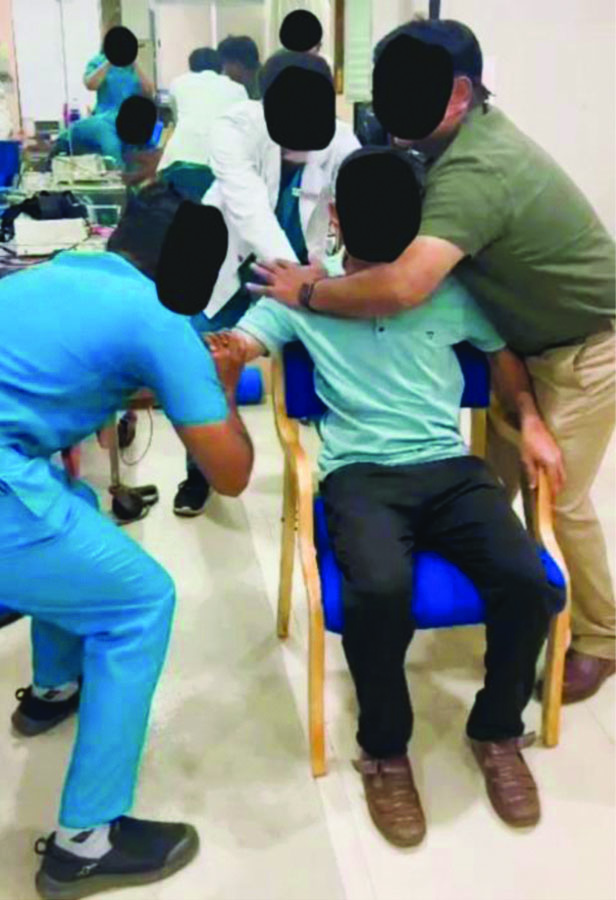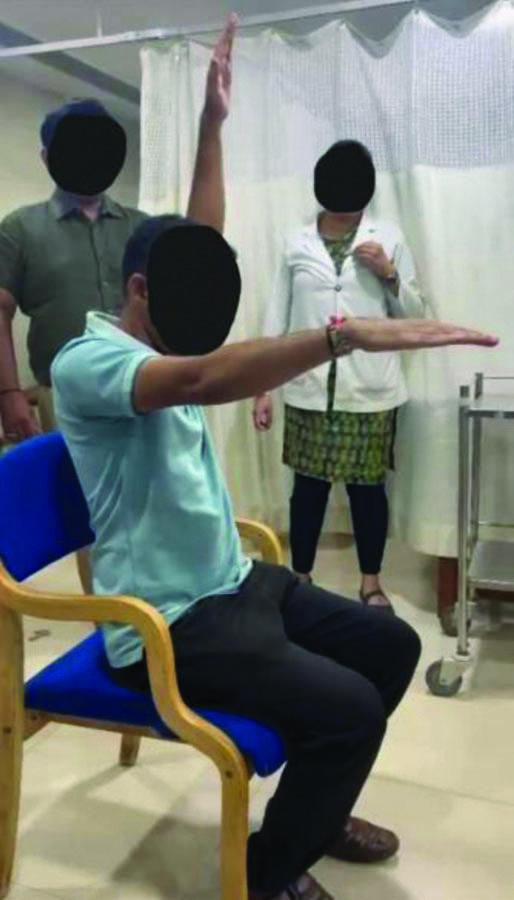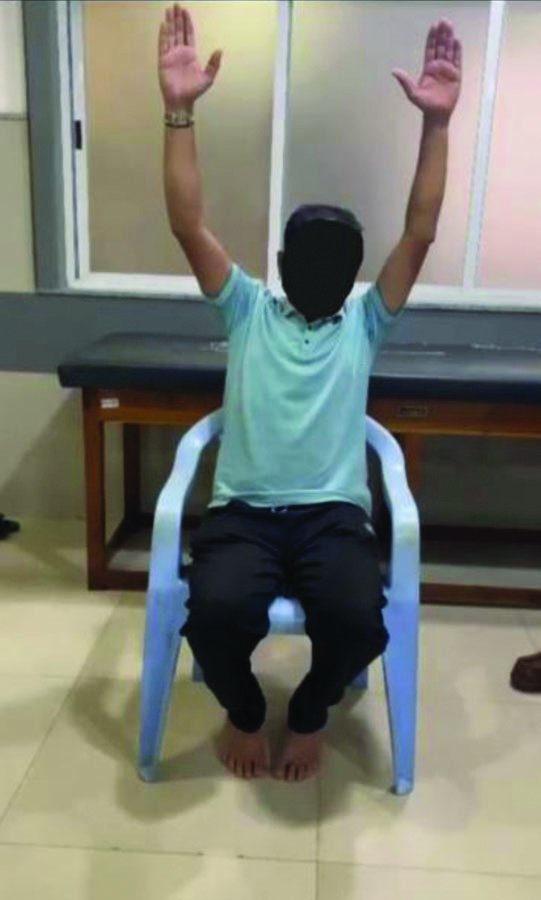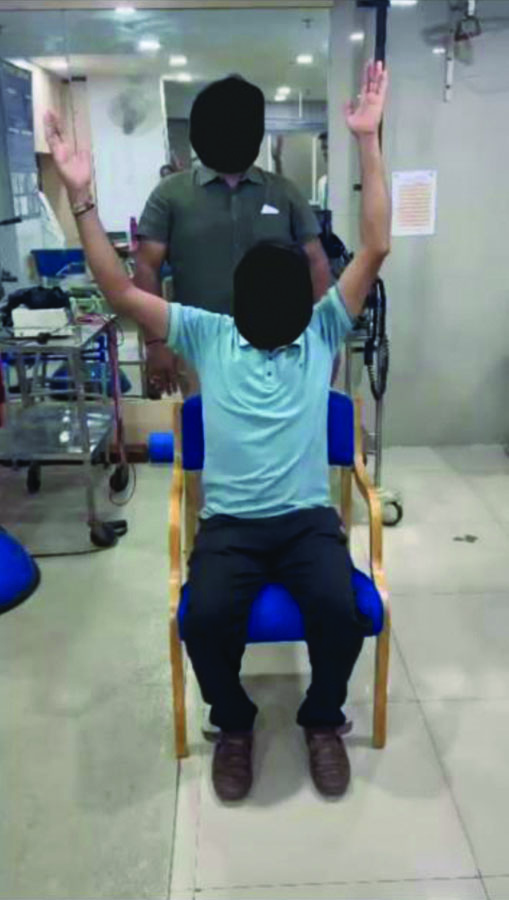Frozen shoulder, or adhesive capsulitis, is a condition characterised by pain and stiffness in the shoulder joint. It gradually worsens over time, making it difficult to move the shoulder. The exact cause is not always clear, but it can be associated with injury, surgery, or certain medical conditions. Treatment typically involves physiotherapy and pain management. The authors present a case of a 41-year-old male who complained of acute pain in the right shoulder joint over a period of 15 days. Examination revealed a restriction in shoulder Range of Motion (ROM). The case was treated with a single session of three therapist-administered posterolateral Mobilisation With Movement (MWM) glides. No medication was prescribed to the patient and he was asked to follow-up in the Outpatient Department (OPD) for three days. The single session of posterolateral MWM glide, along with conventional physiotherapy, led to an increase in shoulder ROM and a reduction in pain. This approach can be considered a viable treatment option for frozen shoulder.
Case Report
A 41-year-old male with a Body Mass Index (BMI) of 24 kg/m2 and no known medical conditions was referred to the orthopaedic manual therapy OPD with complaints of pain in the right shoulder joint. The patient reported experiencing pain and restricted movement in his right shoulder for the past 15 days. He stated that the pain and discomfort began suddenly while he was lifting a heavy bag from his shop.
He was assessed and examined and based on his signs and symptoms special tests were performed, leading to a diagnosis of adhesive capsulitis. No investigations were conducted. On examination, the painful area was located on the anterior and lateral sides of the shoulder joint, with a pain level of 4/10 at rest and 7/10 during activity, as assessed on a visual analogue scale for pain [1]. The ROM for flexion and abduction of the shoulder joint was measured pre- and post-treatment using a universal goniometer [2].
Posterolateral MWM was provided as a treatment for this condition. This is a three-therapist technique. Posterolateral MWM is a manual therapy technique commonly used by physical therapists to address joint pain and dysfunction. The term “posterolateral” refers to the specific direction of the mobilisation, where the force is applied towards the back and side of the joint. This technique targets the posterolateral aspect of a joint, such as the shoulder, knee, or hip, to address issues related to joint stiffness or pain. The intended outcome of posterolateral MWM is an immediate improvement in joint function and a reduction in pain. Repeated sessions may lead to long-term improvement [3].
The patient was seated in a chair with back support and their arm was placed in external rotation while performing flexion and abduction. One therapist stabilised the scapula, while another therapist applied a posterolateral glide to the shoulder joint. The third therapist, using both hands, held near the patient’s elbow to distract and passively abduct the patient’s arm (using a short lever) and provided oscillations until reaching the end range of shoulder abduction, as illustrated in [Table/Fig-1]. This procedure was repeated three times, with 10 oscillations per set for a duration of 10 minutes. The glide was given for a single session and the patient was advised to follow-up for three days.
Three therapist technique.

After the treatment, the patient was asked to actively perform shoulder flexion and abduction to assess his ROM and pain [Table/Fig-2,3 and 4]. The ROM was evaluated using a universal goniometer [2].



Immediately after one session of posterolateral MWM glide, the patient reported no pain Visual Analogue Scale (VAS) and there was a significant improvement in shoulder flexion and abduction ROM [Table/Fig-5]. The patient was advised to follow-up in the OPD after three days [Table/Fig-6] [1].
| Preintervention shoulder ROM | Postintervention shoulder ROM |
|---|
| Shoulder flexion=45* | Shoulder flexion=160* |
| Shoulder abduction=60* | Shoulder abduction=120* |
Postabduction taken on follow-up day.

Discussion
The current study showed that a single session of postero-lateral MWM glide was effective in reducing pain and increasing shoulder ROM. The posterolateral glide targets the glenohumeral joint, which is the main joint of the shoulder. By applying gentle pressure in a postero-lateral direction (towards the back and side), therapists aim to mobilise the joint surfaces that may be restricted or stiffened due to injury, overuse, or poor posture. The postero-lateral glide can be particularly effective in addressing shoulder impingement syndrome. Impingement occurs when structures (such as tendons or bursa) become compressed within the shoulder joint during movement, leading to pain and restricted motion. By mobilising the joint and creating more space between these structures, the postero-lateral glide can alleviate impingement symptoms and allow for smoother shoulder flexion and abduction [4].
For individuals recovering from shoulder injuries or surgeries, restoring normal joint mobility is crucial for promoting healing and preventing long-term stiffness or dysfunction. The postero-lateral glide can facilitate this recovery process by maintaining or improving shoulder flexibility and function [5].
In the review article “The Initial Effects of Mulligan’s MWM Technique on Range of Movement and Pressure Pain Threshold in Pain-limited Shoulders” by Pamela Teys, Leanne Bisset and Bill Vicenzino, the authors analyse the effects of Mulligan’s MWM technique on shoulder pain and function. The review discusses how MWM, which combines passive joint mobilisation with active movement, can lead to improvements in both shoulder ROM and pressure pain threshold in individuals experiencing pain-limited shoulder conditions. The review evaluates existing literature and clinical studies to assess the effectiveness of MWM in enhancing shoulder mobility and reducing pain sensitivity, providing valuable insights for clinical practice [6].
The study titled “Combined Effect of End Range Mobilisation (ERM) and MWM techniques on ROM and disability in frozen shoulder patients: a randomised clinical trial” by Goyal, Bhattacharjee and Goyal explores the efficacy of combining ERM with MWM techniques in treating frozen shoulder [7]. This randomised clinical trial aims to assess how this combined approach affects both ROM and disability in patients suffering from this condition.
The literature review underpinning the present study highlights that frozen shoulder, characterised by restricted shoulder movement and significant pain, often requires comprehensive management strategies. Previous research indicates that both ERM and MWM techniques, when used individually, can be beneficial in improving shoulder mobility and reducing pain. ERM involves mobilising the shoulder joint at its end range to increase motion, while MWM combines passive mobilisation with active movement to enhance functional outcomes.
The review suggests that integrating these techniques could offer synergistic benefits, potentially leading to greater improvements in ROM and functional disability than when either technique is used alone. The study aims to contribute to this body of evidence by evaluating the combined impact of ERM and MWM, providing insights into their effectiveness and practical application in the treatment of frozen shoulder [7].
A study conducted at Hospital H in Ulsan, Korea, aimed to compare the effectiveness of Maitland and Kaltenborn mobilisation techniques in reducing pain and improving the ROM in patients with frozen shoulder. A total of 20 patients were randomly assigned to either the Maitland or Kaltenborn mobilisation group. The Maitland group received Grade III anteroposterior oscillations, while the Kaltenborn group received posterior translations. Both groups were assessed for pain and the ROM in external and internal rotation before and after the intervention. The results indicated significant reductions in pain and improvements in the ROM for both groups, with no significant difference between them. The findings suggest that both Maitland and Kaltenborn mobilisation techniques are effective in alleviating pain and enhancing the ROM in patients with frozen shoulder, making both techniques viable treatment options [8].
Hubbard TJ and Brantingham JM systematic review critically evaluates the efficacy of Mulligan’s MWM for pain reduction in shoulder dysfunction. The review synthesises evidence from various studies to assess how MWM impacts pain management and functional outcomes in patients with shoulder disorders, including frozen shoulder. Mulligan’s technique, which integrates passive mobilisation with active movement, is examined for its ability to alleviate pain and enhance ROM. The review highlights that MWM can be effective in providing pain relief and improving shoulder function, although the quality and consistency of evidence vary across studies. The authors discuss the practical application of MWM in clinical settings, noting its potential benefits and limitations. Overall, the review supports the use of Mulligan’s MWM as a viable option for managing shoulder pain, emphasising the need for further research to strengthen the evidence base and refine clinical guidelines [9].
Cleland JA and Childs JD clinical commentary, published in the Journal of Orthopaedic and Sports Physical Therapy, explores the effects of Mulligan’s MWM for managing shoulder pain and dysfunction. The commentary reviews various studies and clinical experiences related to MWM, highlighting its application in treating conditions such as frozen shoulder. Mulligan’s MWM is noted for its approach of combining passive joint mobilisation with active movement, aimed at reducing pain and improving functional mobility. The authors discuss the evidence supporting MWM, including its effectiveness in decreasing pain and increasing the ROM for patients with shoulder disorders. They also address practical considerations and clinical implications, emphasising that MWM can be a valuable addition to treatment strategies for shoulder pain, particularly when traditional methods are insufficient. The commentary provides a thorough overview of the technique’s benefits and limitations, offering insights for clinicians on incorporating MWM into their therapeutic practices [10].
SAI KV and KUMAR JS examines “Effects of Mulligan’s Mobilisation with Movement on Pain and Range of Motion in Diabetic Frozen Shoulder: A Randomised Clinical Trial” which focuses on the impact of Mulligan’s Mobilisation with Movement (MWM) technique on patients with type-2 diabetes suffering from frozen shoulder. The trial included 66 participants who were randomly assigned to two groups: the control group, which received supervised exercises alone, and the experimental group, which received both MWM and supervised exercises. The outcomes measured were pain levels, Active Range of Motion (AROM), and functional ability, assessed at the beginning, and after 3, 6, and 12 weeks of treatment. The results showed significant improvement in both groups, but the group receiving MWM saw notably better outcomes. Specifically, the MWM group experienced a 23.4° greater improvement in abduction AROM and a 20.4° greater improvement in internal rotation AROM compared to the control group. Additionally, pain and shoulder disability were significantly reduced in the MWM group by the end of 12 weeks. In conclusion, MWM, when combined with supervised exercises, was found to be more effective in improving range of motion, reducing pain, and enhancing functional ability in diabetic patients with frozen shoulder [11].
Conclusion(s)
The case report demonstrated improvement in shoulder ROM and a reduction in pain following a single session of the posterolateral MWM glide. Therefore, this technique can be considered a viable treatment option for frozen shoulder.
[1]. Boonstra AM, Schiphorst Preuper HR, Reneman MF, Posthumus JB, Stewart RE, Reliability and validity of the visual analogue scale for disability in patients with chronic musculoskeletal pain Int J Rehabil Res 2008 31(2):165-69.10.1097/MRR.0b013e3282fc0f93 [Google Scholar] [CrossRef]
[2]. Riddle DL, Rothstein JM, Lamb RL, Goniometric reliability in a clinical setting: Shoulder measurements Phys Ther 1987 67(5):668-73. [Google Scholar]
[3]. Mulligan BR, Manual Therapy: “NAGS”, “SNAGS”, “MWMS” etc. 2010 6th edWellingtonPlane View Services:45-50. [Google Scholar]
[4]. Kisner C, Colby LA, Therapeutic Exercise: Foundations and Techniques 2012 6th edPhiladelphiaF.A. Davis Company:520-525. [Google Scholar]
[5]. Brukner P, Khan K, Clinical Sports Medicine 2012 4th edSydneyMcGraw-Hill:405-10. [Google Scholar]
[6]. Teys P, Bisset L, Vicenzino B, The initial effects of a Mulligan’s mobilization with movement technique on range of movement and pressure pain threshold in pain-limited shoulders Man Ther 2008 13(1):37-42.10.1016/j.math.2006.07.015 [Google Scholar] [CrossRef]
[7]. Goyal M, Bhattacharjee S, Goyal K, Combined effect of End Range Mobilization (ERM) and Mobilization with Movement (MWM) techniques on range of motion and disability in frozen shoulder patients: A randomized clinical trial Journal of Exercise Science and Physiotherapy 2013 9(2):74-82. [Google Scholar]
[8]. Do Moon G, Lim JY, Da YK, Kim TH, Comparison of Maitland and Kaltenborn mobilization techniques for improving shoulder pain and range of motion in frozen shoulders Journal of Physical Therapy Science 2015 27(5):1391-5. [Google Scholar]
[9]. Westad K, Tjoestolvsen F, Hebron C, The effectiveness of Mulligan’s mobilisation with movement (MWM) on peripheral joints in musculoskeletal (MSK) conditions: A systematic review Musculoskeletal Science and Practice 2019 39:157-63. [Google Scholar]
[10]. Stathopoulos N, Dimitriadis Z, Koumantakis GA, Effectiveness of Mulligan’s mobilization with movement techniques on pain and disability of peripheral joints: a systematic review with meta-analysis between 2008-2017 Physiotherapy 2019 105(1):1-9. [Google Scholar]
[11]. Sai KV, Kumar JNS, Effects of Mulligan’s mobilisation with movement on pain and range of motion in diabetic frozen shoulder a randomized clinical trail Indian Journal of Physiotherapy and Occupational Therapy 2015 9(4):187-93.Available from: https://www.indianjournals.com/ijor.aspx?target=ijor:ijpot&volume=9&issue=4&article=036 [Google Scholar]